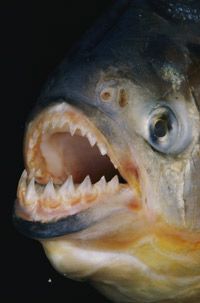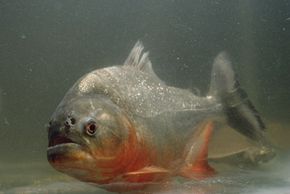
The size of piranhas is not their defining feature, as most are only about 8 inches (20 cm) in length and weigh just a few pounds. However, their teeth are razor sharp and interlock like scissors when their jaws snap shut, making them incredibly efficient at chomping. Piranhas don’t chew their food, but rather swallow large chunks of flesh whole, and are able to strip a large animal down to a skeleton in a matter of minutes due to their efficiency in team eating. Feeding frenzies, like the one witnessed by Theodore Roosevelt, occur when piranhas are starving and are not a regular occurrence. Piranhas are usually eaten by herons and caimans during the dry season when they are trapped in small pools with no food.
Feeding Habits of Piranhas

Most piranhas, such as the red-bellied piranha pictured here, typically nip at other fish as they swim by. While piranhas are known to attack sickly and old animals that come to drink from the river, it is unlikely they could take down a healthy, full-grown human. Piranhas are primarily scavengers and do not rely on live prey for sustenance. The skeletons of animals and people found in the Amazon that were apparently eaten by piranhas were already dead when the piranhas consumed them.
Although piranhas are not strict carnivores, they mainly eat other fish and sometimes even other piranhas. Piranhas will also eat fruits and plants, particularly when they are young. Contrary to popular belief, only 12 of the 20 species of piranhas in the Amazon survive entirely on taking small bites out of the fins and scales of other fish as they pass by. The fish they attack swim away relatively unharmed, and their fins and scales grow back.
While piranhas are not the vicious man-eaters of myth, incidents of attacks on humans have been increasing in frequency. People in South America have been losing fingers and toes more often than they were just a decade ago, and experts suspect this may be due to an increase in the number of dams on the Amazon River. Dams slow the current, and piranhas like to breed in the slowest-moving waters. Creating more placid areas along the river attracts piranhas to come set up camp in large numbers. This also attracts swimmers, bringing humans and piranhas into contact more frequently.
Piranhas are native only to South America, but they have been appearing in rivers worldwide over the past few decades. This is most likely due to people who keep piranhas as pets releasing them into nearby bodies of water. This poses a serious threat to the ecological balance in these areas, and many countries have banned the importation of piranhas entirely.
Is the myth true? Can piranhas devour a cow in less than a minute? Author’s Note
One of my favorite types of articles to write are those that investigate pop-culture or common-knowledge “facts” to uncover the truth, fiction, or mystery behind them. When my editor gave me the assignment to explore whether piranhas could strip a cow to the bone in under a minute, I was excited, as I thought I had seen piranhas on a scuba-diving trip years ago.
However, as I began my research and looked at pictures of these creatures, I realized that I had not actually seen piranhas, nor was I even in South America at the time.
As for the cow myth, it turns out that it is mostly true, even though the incident described by Teddy Roosevelt was staged (poor cow). Piranhas, despite being relatively small fish, can indeed quickly remove all the flesh from a cow. Although they don’t usually feed in this manner, it’s still unsettling to know that it’s possible (and it definitely discourages me from swimming in the Amazon, should I ever have the opportunity). The exact time it takes for them to devour a cow seems irrelevant.
Sources of Information
- The BBC News reported on China’s order to destroy piranhas on December 24, 2002 (source).
- On June 1, 2000, the BBC News shared a story of a hungry piranha seeking a good catch (source).
- The Encyclopedia Britannica provides some information on piranhas (source).
- The website Extreme Science also has a page dedicated to piranhas (source).
- HowStuffWorks offers some interesting facts about piranhas on their website (source).
- The BBC News reported on the increase in piranhas due to dams on December 28, 2003 (source).
- The London Aquarium provides a fact sheet on piranhas on their website (source).
- The LA Times published an article about Amazon’s killer piranha on November 22, 2005 (source).
- Keith Sutton’s article “Catfish” on ESPN.com talks about his experience with piranhas in the wilderness (source).
- Practical Fishkeeping has an article on the truth about piranha attacks (source).
Piranhas: Quick Facts
What you need to know:
- Despite their predatory abilities, piranhas are relatively small, ranging from 8 to 24 inches in length. The most vicious ones are usually on the smaller end of the range.
- Piranhas do not always kill their prey. They often take small, non-fatal bites out of passing fish or eat food that is already dead.
- Former U.S. President Theodore Roosevelt was an adventurer in the wilderness.
- Piranha feeding involves teamwork, with each fish taking a bite and then moving aside to allow another fish to continue. This rotation allows them to quickly strip their prey and creates a “boiling” effect in the water.
- While a large group of piranhas could certainly strip a cow, it is unlikely that they could do it in under a minute.
Test Your Knowledge with These Quizzes:
- Travel the World: Brazil
- The Ultimate Friendliest Destination on the Planet Quiz
- The Ultimate Taking Action Photos Quiz
- The Ultimate Fisheries Quiz
- The Ultimate Survival Skills Quiz
Check Out These Image Galleries:
- Fishing Pictures
- Amphibian Pictures
- Aquarium Fish Pictures
- Marine Mammal Pictures
- President Pictures
FAQ
1. Is it true that piranhas can strip a cow to the bone in under a minute?
Yes, it is possible for a large group of piranhas to strip a cow to the bone in under a minute. However, this is not a common occurrence and is mostly seen in extreme situations where the piranhas are starving and have no other food source. In normal circumstances, piranhas feed on smaller fish, insects, and crustaceans.
2. How many piranhas would it take to strip a cow to the bone?
The number of piranhas needed to strip a cow to the bone depends on various factors, such as the size and weight of the cow, the hunger level of the piranhas, and the duration of the feeding frenzy. However, it is estimated that it would take around 300 to 500 piranhas to strip a cow to the bone in under a minute.
3. Are piranhas dangerous to humans?
While piranhas are known for their sharp teeth and aggressive feeding behavior, they are not usually a threat to humans. Most piranha attacks on humans happen when people enter the water where piranhas live, especially if they have an open wound or are bleeding. However, these attacks are rare and can be avoided by staying away from areas where piranhas are known to live.
4. What do piranhas usually eat?
Piranhas are omnivorous and feed on a variety of prey, including fish, insects, crustaceans, and even small mammals and birds. They are opportunistic feeders and will eat whatever is available in their environment.
5. Where do piranhas live?
Piranhas are native to South America and can be found in rivers, lakes, and streams throughout the continent. They prefer warm, shallow waters with plenty of vegetation and hiding places.
6. How fast can piranhas swim?
Piranhas are fast swimmers and can reach speeds of up to 15 miles per hour (24 kilometers per hour). This allows them to catch their prey quickly and efficiently.
7. How many species of piranhas are there?
There are around 30 to 60 species of piranhas, depending on the classification system used. Some of the most well-known species include the red-bellied piranha, black piranha, and yellow piranha.
8. Do piranhas have any predators?
Yes, piranhas have several predators, including river dolphins, caimans, and large fish such as the arapaima. Juvenile piranhas are also preyed upon by larger fish and birds.
9. Are piranhas endangered?
Most species of piranhas are not considered endangered, but some populations have been affected by habitat loss and overfishing. The black piranha, in particular, is listed as a vulnerable species by the International Union for Conservation of Nature (IUCN).
10. Can piranhas be kept as pets?
Yes, piranhas can be kept as pets, but it is important to do so responsibly. Piranhas require large aquariums with plenty of hiding places and a varied diet of live or frozen foods. It is also important to research the specific needs of the species of piranha you plan to keep and to avoid introducing them into natural waterways if you can no longer care for them.
11. Are there any myths or misconceptions about piranhas?
Yes, there are many myths and misconceptions about piranhas, including the idea that they are bloodthirsty man-eaters. In reality, piranhas are mostly scavengers and opportunistic feeders that rarely attack humans. Other myths include the idea that piranhas can kill a cow in seconds or that they are attracted to the scent of blood from miles away, neither of which is true.





Leave a Reply